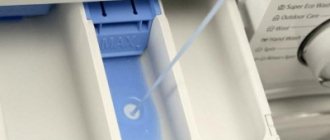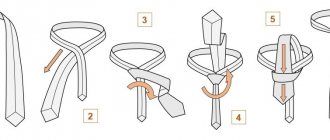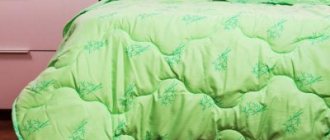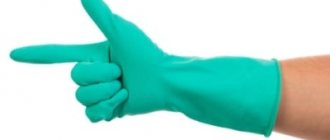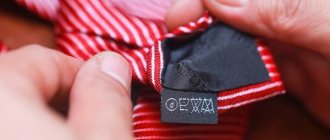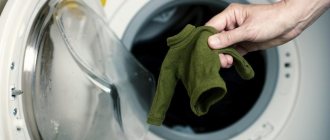To maintain the neat, presentable appearance of this accessory, you should know how to properly care for it: wash, dry, iron and store.
So, is it possible and how to properly wash a men’s tie at home?
Can it be washed?
Before you start washing your tie, you need to find the label for the item and find out what kind of exposure it can be exposed to .
Based on the information provided by the manufacturer himself, the possibility and conditions of washing are determined.
Some ties cannot be washed at all and must be dry cleaned. These exceptions include some models with complex designs or made from very delicate fabrics.
But most can be cleaned and refreshed at home without any problems . The main thing is to take into account the characteristics of the material. For example, natural silk is washed only by hand in a weak soap solution.
Regardless of the material of manufacture, aggressive agents and intense friction are not used to clean ties. But stain removers designed for the care of delicate fabrics can be used. If there are stains on the fabric, you should try to remove them before washing the item.
Before processing, it is recommended to check the durability of the paint. To do this, lightly rub the material from the inside out with a damp white cloth. If the fabric is stained, then you can wash such a tie only by hand, using minimal water and reducing the processing time.
The care instructions given by the manufacturer should not be violated. Based on the information on the tag, you can determine what kind of care the item requires. The symbols have the following meaning:
Background
Something similar was also used in Ancient China, from where, apparently, the methods of tying it came to Rome, where it was used by legionnaires. But at that time it was still shaped like a scarf.
This fashion came to Europe in the seventeenth century. At that time it was something like a scarf tied with a special knot. Ordinary citizens began wearing it in France at the end of the nineteenth century.
Depending on appearance, the following types are distinguished:
- Regatta (Windsor) - its length reaches 147 cm, the knot is 7–9 cm.
- Ascot - designed for more formal events, its shape resembles a scarf tied with a special knot.
- A butterfly is a small piece of fabric tied in such a way that it resembles a bow.
- Bolo – a brooch made of wood or expensive stones is used for fastening.
- And others.
How to machine wash?
Machine wash simplifies the process of caring for things . But this method is not suitable for all ties.
If there is no prohibition on machine processing, you must act taking into account all the requirements for caring for the item. The choice of detergent, temperature and mode setting requires special attention.
Which product should I choose?
A tie is a delicate item. To wash it, it is recommended to use liquid detergents in gel form. They dissolve better and are distributed more evenly in water when compared with powders.
Poorly dissolved detergent can ruin the item due to the granules it contains.
Temperature and mode
The choice of washing mode determines the degree of intensity and duration of exposure. “Delicate” is optimal.
In this case, some processing parameters will need to be adjusted:
- spin – turn off;
- set the temperature to no higher than +40°C (in accordance with the manufacturer’s recommendations on the product label);
- The duration of washing is no more than an hour.
The delicate material of the tie may be damaged if it comes into contact with the drum of the washing machine and other things. To prevent this, it is recommended to use a laundry bag for delicate items or a special container.
Tie storage
- At the end of the working day, be sure to loosen your tie. Hang the product on a special hanger at a certain distance from other things. This move will straighten the tie, it will return to its original shape.
- This hanger has an anti-slip coating, so there is no risk that the tie will fall. With the help of this type of device, delicate items are stored many times longer than on a shelf.
- If you don’t have time to stock up on such hangers, you can use a simpler and no less convenient method - roll the tie into a roll and put it in the closet.
- Every time you tighten your tie, you should not make too strong knots. These manipulations have a detrimental effect on the material. In the future, the tie will be more difficult to straighten.
- If you notice slight dirt on your tie, you do not need to resort to a full wash. Use special stain removers. Apply a small amount of the composition, wipe the item after a while with a damp cotton pad or sponge. Then rinse off the foam with a warm stream of water.
- Lemon juice will help get rid of simple stains. Table salt is effective against traces of red wine, lipstick, and coffee. Ammonia (ammonia), hydrogen peroxide, and dishwashing detergent are suitable for getting rid of any types of dirt.
- After the main washing procedure, silk ties should be rinsed in slightly salty warm water. This procedure helps preserve the original color and shine of the fabric.
- When using a stain remover, apply the one intended for colored items. If you wash a tie in light colors, do not worry, the product will add shine and will not ruin the product.
- Do not wash several items at the same time; it is better to perform such manipulation sequentially. Do not leave your tie to soak in a sink or container. Otherwise, the fabric may stretch and wrinkles may form.
- If you have made such a mistake, the item has stretched, creases have appeared on the fabric, after drying, treat it with steam from an iron or a special steamer.
- Try to wash delicate items as little as possible. Such products do not withstand frequent exposure to detergents and quickly lose their original appearance.
It’s easy to wash a tie at home if you follow the step-by-step instructions and main features. First of all, prepare a template from cardboard, wrap it with polyethylene, protecting it from moisture. Choose a gentle cleaning product. Perform manipulations exclusively by hand, familiarize yourself with the composition of the fabric. Perform a full wash of delicate items only in extreme cases. Store the tie correctly, protecting it from deformation.
Manual processing
Hand washing allows you to wash your tie very carefully, paying attention to the stained areas. For this:
Warm water (up to +40°C) is poured into the prepared container.- Dilute the detergent.
- After foam appears, carefully lower the tie into the basin.
- Leave for 15-30 minutes.
- Using a soft sponge, smooth the tie along the tie at an angle.
- Rinse, changing the water. If you are not sure about the composition of the material, then you should rinse the product several times, gradually lowering the temperature.
During the washing and rinsing process, all movements should be directed only diagonally to avoid twisting of the material and deformation of the shape.
Manual procedure
Washing a tie should also be done correctly so as not to damage the product.
Before doing this, you should make sure that the accessory does not fade. How to wash correctly:
- Prepare powder for delicate fabrics or colorless hair shampoo in advance.
- Next, you need to prepare a stencil, which is cut out of thick cardboard. It must accurately describe all the curves of the tie. The stencil is wrapped in cling film to prevent water from soaking it. Then the accessory that needs to be washed is placed inside it and secured with tape.
- In this form, the product is placed on the bottom of a basin with a prepared soap solution, which should first be whipped into foam, and left in it for 30 minutes.
- After this, the accessory is removed from the stencil and gently cleaned with a soft sponge. The tie should not be twisted or wrung out to prevent creases from appearing.
If a man's tie can be washed, it is better to do it by hand. In this case, it is necessary to use powder for delicate hand washing. This product is gentle on your hands and will not damage the fibers of the fabric.
Add a little washing powder to a bowl of warm water at a temperature no higher than 40 degrees or dissolve shavings from laundry soap. The straightened product is dipped into a soap solution and soaked for half an hour. You should not soak several ties at the same time; it is better to wash them sequentially.
Wash by hand
Then the accessory is washed by wiping with a sponge or cloth. Apply a little liquid detergent to it and gently wipe the stained areas until the stains disappear. After this, the accessory is rinsed under cool running water until all traces of powder or washing gel are washed out. To preserve the brightness of the colors, it is recommended to additionally rinse the product in salted water.
Taking into account the material
The material from which a tie is made is one of the main factors influencing the possibility and method of washing an item.
From a practical point of view, expensive models made from natural fabrics are more demanding to care for than mixed and synthetic ones.
Natural silk
This material is one of the most expensive and elite . It is made from the cocoon of the silkworm.
A silk tie, unless prohibited by the manufacturer, is washed by hand, very carefully, completely eliminating friction. For washing, it is best to use a soap solution or products that are marked accordingly - “for washing products made from natural silk.”
Synthetics
This material is a budget alternative to natural silk . Such ties are less demanding to care for.
In most cases, they can be washed by hand and on the delicate cycle of the washing machine.
If you have the option of choosing a tie made of synthetic material, then it is better to give preference to microfiber rather than polyester, which is inferior in quality and visual appeal.
Cotton and linen
Natural cotton and linen are often chosen to create informal youth designs. And also for sewing summer accessories.
Even in mixed fabrics , both cotton and linen require delicate handling . Otherwise, the material may shrink, fade and lose its shape.
Wool
Wool ties are found in winter collections. As a rule, they are presented in classic colors and well-crafted materials.
This fabric requires precise control over the washing temperature. Typically it should not exceed +30°C.
Wet wool is very sensitive to any impact , so washing, if permissible, should be done in cool water, without prolonged soaking. Such ties are dried only in a horizontal position, well straightened.
Removing stains at home
Unexpected accidents can cause stains to appear on your tie. You can remove them more efficiently if you know what exactly left them.
It is recommended to act as quickly as possible so that the dirt is not absorbed into the deep layers of the material, and the stain itself does not become old.
Lipstick
Lipstick leaves behind complex stains that ordinary gels and washing powders cannot always cope with. Special household chemicals can help.
One of these products is Lion stain remover (manufactured in Japan). It can be used to process natural and synthetic materials, removing not only traces of lipstick, but also contaminants such as coffee and sauce stains. Cost 220 ml - from 400 rubles.
The Udalix compact stain remover will help you deal with many stains, including lipstick. The price of a “pencil” is from 100 rubles. This product is convenient to use and can even be taken on trips.
Ink
The mark left by a ballpoint pen can be removed by squeezing fresh lemon juice onto the cloth. After this, the tie is left for about 5 minutes. After the stain disappears, the product is cleaned.
If the stain remains stubborn, you can use Udalix, as with lipstick. This product is effective in removing chemical dyes, including pen ink.
Chocolate
A fresh chocolate stain can be removed with just soapy water.
The tie is carefully washed and then rinsed. Another way to remove stains is to use glycerin:
- Heat the glycerin to +35°C in a water bath.
- Apply to the area of contamination.
- Leave for a quarter of an hour.
- Wash with water at room temperature.
Fat
A greasy stain can be quickly removed using regular dishwashing detergent. Work order:
- moisten the sponge;
- Apply a little dishwashing detergent to the sponge and treat the affected area of the tie;
- leave for 10-15 minutes;
- walk with a damp sponge, removing any remaining detergent.
Another way to deal with greasy stains is TM Lion.
Alcoholic drinks
The stain can be removed without consequences if you start working while it is fresh:
- Sprinkle the stain generously with salt.
- Wait for the pigment to be absorbed.
- Clean off any remaining salt.
- The product is washed.
The second option to tidy up your tie after the party:
- mix 1 tsp. wine alcohol and glycerin;
- apply the composition to the stain using a sponge;
- leave for 2 hours;
- clean with a brush or sponge;
- wash the tie in cool water.
The last recipe will help even in cases where the stain has dried out.
Blood
For blood stains, a recipe based on ammonia will help.
Procedure:
- Mix a little ammonia with the same amount of water.
- Using a sponge, gently moisten the stain, avoiding rubbing.
- After the stain disappears, treat the area with a sponge soaked in clean water. Or - wash it.
In addition to ammonia, hydrogen peroxide will help remove blood. It is applied to the stain. After the reaction is complete, wash the tie in cool water.
Prolonged exposure to hydrogen peroxide and ammonia can lead to washing out and discoloration of paints.
How can you refresh a product and remove weak stains?
The best way to clean a tie is to clean it by hand without using strong detergents.
You can and should wash a tie, although there is an opinion that this item of clothing should never be wet. You can soak and soak and remove stains, but you need to do it the right way.
To do this, you will need an oxygen-containing stain remover, which is applied to a cotton pad and firmly applied to the contaminated area. After 3-5 minutes, the disc is removed and the area is wiped with a clean cloth or napkin.
You can remove any remaining product using a damp foam sponge soaked in warm water. Usually, these measures are enough to eliminate fresh stains that have not yet been ingrained into the structure of the material.
If you don't have a stain remover, you can use the following:
- ammonia - will help cope with blood stains;
- neutral detergent - will remove fresh greasy stains;
- table salt – effectively removes alcohol and traces of alcohol;
- Citric Acid – Can help with marks from water-based paints and inks.
If after carrying out the procedures it was not possible to remove the stain, then hand washing is indispensable. You should not try to remove the stain using the same method several times. It is better to wash the product correctly once than to repeatedly expose the fabric to agents that affect the structure of the fabric.
Sequence of hand washing a tie
Removing various types of stains can be done using external solutions
Before you begin, you should determine what fabric the tie was made from. To do this, carefully read the label sewn to the product and decipher the symbols.
But even regardless of the type of fabric, when washing a tie, follow two important rules:
- wash the product only by hand - this will avoid deformation of the item that occurs with delicate fabrics when machine washed;
- do not rub, do not use brushes and sponges with a hard base - during the cleaning process, the use of third-party objects to remove dirt is not allowed, as rough materials can lead to the formation of snags, abrasions, etc.
Washing a tie made of natural silk is done in lukewarm water. As a detergent, it is better to use special compositions for silk and natural baby soap, which are pre-dissolved.
Before washing, such a tie is soaked for 15-20 minutes. Then rinse very carefully in soapy water. Water of the same temperature is used for rinsing. You cannot wring or twist the tie.
If you want to give the color of the product a more saturated shade, then when rinsing, add 100 grams of salt per 3 liters of boiled water. We dip the item in a salty solution a couple of times, then let the bulk of the absorbed water drain and send the item to dry.
Ties made from synthetic fabrics are cleaned in a similar way. The item is washed in soapy foam. Then rinse in slightly warm and then cool water.
How to dry and iron correctly?
When storing, roll the tie into a roll - this will prevent the formation of wrinkles on the product
The tie is dried only after the bulk of the water has drained off on its own. Next, you can put the product between two cotton fabrics or towels for 5-7 minutes.
For ironing, we use an iron with a ceramic or non-stick base. Iron through damp gauze or cotton cloth at temperatures up to 130 °C. If you want to get the perfect result, then cut out the blank from cardboard and put it inside the product. This will eliminate the formation of unnecessary bends and marks from the seams.
Care instructions
Washing a tie or other item made from delicate fabric is always a necessary measure. It is advisable that such measures be taken less frequently, since excessive use of washing will inevitably lead to rapid damage to the item.
In order for a product to serve for many years, it needs proper and timely care:
- After a working day or long wear, the product needs to be unraveled.
- For storage, a regular hanger with a horizontal bar or a special hanger for ties is best suited.
- When traveling or in a hotel where there is no direct access to closets, the tie can be rolled up and stored on any flat surface.
- When tying, do not tighten the knot too tightly. This will prevent the formation of rough folds and make you feel more comfortable.
Otherwise, try to keep track of any item in your wardrobe. Sometimes it is better to be careful once again than to spend a long time looking for a replacement for a damaged product.
Drying Features
The extent to which the shape of the tie will suffer will largely depend on the correctness of the washing. At all stages of processing it is necessary to control so that the fabric wrinkles less. You should also not twist or wring out the item with force .
After hand or machine washing, place the tie between two layers of terry towel and gently wring it out. Excess water will be removed. After this, the tie needs to be dried, carefully straightening out any possible creases and folds.
You can use one of the options:
- spread on a horizontal, flat surface on a towel;
- hang vertically on a rope.
Trying to speed up the drying process with improvised means (hairdryer, placing it near a heat source, etc.) is not worth it - the tie may fade and lose its shape.
How to stroke?
Improper ironing can significantly damage the item, even rendering it unusable. To prevent this from happening, the following points should be taken into account:
Do not iron a stained tie. The stains will harden under the influence of high temperatures, after which it will be almost impossible to remove them.- Ironing should be done at a low temperature (preferably at the temperature recommended by the product manufacturer).
- The ironing process must be carried out through additional fabric, for example, several layers of gauze.
- Additional moisture will help iron the accessory better.
- The movements of the iron should be in one direction.
- You should not put pressure on the iron during ironing - the seam located on the back of the product may be imprinted.
- If the fabric is very thin, then when ironing the wide part of the tie, it is recommended to place a cardboard insert inside the product. This will help prevent the back seam from imprinting on the front side. It is better to cut out such a liner in advance.
Ironing can be replaced with a steamer if the material allows it.
Ironing
It is not recommended to iron a tie, as this will cause it to lose its strict shape and fade. For this purpose, you can buy a portable steamer that is suitable for delicate items. It perfectly aligns the fabric without damaging it at all. But it is not always possible to use this device.
You can also iron a tie at home, but this only applies to extreme measures. There are a few rules to keep in mind:
- The item must be clean before ironing. Do not iron if there are stains, otherwise they will not wash off.
- Ironing should be done through a wet gauze cloth.
- Apply just a little pressure on the iron.
We suggest you read: How to clean a car air filter with your own hands
To make this piece of clothing look perfect, you need to iron the tie. Carefully study the label on the back of the product - it indicates at what temperature the item made of a particular material should be ironed. Do not overheat the iron or use steam, especially if the product is starched.
Even if you managed to avoid making mistakes when washing, the risk of this remains when ironing. Therefore, you need to take a particularly responsible approach to this process.
A high-quality iron will make it possible to reduce the risk of incidents during work.
Be sure to place damp gauze between the iron and the tie. To prevent seams on the back side from imprinting onto the front side, you can use a cardboard insert.
But you should not use the template that was made in the previous paragraph. Since plastic or tape can melt and solder when the temperature rises.
This process adds elegance, but if you are still afraid of using an iron, a steamer can come to your rescue. It allows you to quickly and efficiently get rid of wrinkles.
After drying, the question arises, how to iron ties at home? There is also nothing complicated in this procedure. After the first time, subsequent ironing will take place automatically, your hands will do what you need.
Every housewife should know how to iron a tie, because this accessory is always in sight. If the procedure is carried out without using an iron, then the product is simply rolled into a tube and left in this form for several hours.
How to iron a tie?
Silk accessories can only be treated with steam at a distance of at least 10 cm from the product. Products made from other types of fabrics can be ironed when they are still damp, the main thing is to observe the temperature regime of the electrical appliance and carry out the manipulation through gauze.
How to store it correctly?
Proper storage of the accessory can simplify the problem of wrinkled ties. To do this, you can use one of the options:
- You need to purchase a special case in which the ties are stored compactly folded. Such cases are convenient to install, for example, in a dresser drawer.
- Use special covers. This option is optimal for transportation. Covers come in rectangular and round shapes.
- Placement on a hanger. This is the most popular option, allowing you to store your tie in a loose position by unraveling the knot.
Models of ties that are made from cashmere or other types of wool cannot be stored hanging due to the risk of deformation.
Recommendations
Washing a tie requires care, increased attention and strict adherence to the instructions on the product label.
The following tips will provide additional assistance in caring for your item:
If the tag to the item has not been preserved, it is advisable not to use machine washing, but to treat care as correctly and carefully as possible.- Hot water is not acceptable for washing any ties.
- To rinse a tie, you should use water at a temperature that is not in contrast to that used for washing.
- For rinsing, you can use lightly salted water (50 grams of salt per 2 liters of water). This will help better preserve the freshness of the item and the brightness of the colors.
- If you don’t have a steamer or an iron at hand, rolling it up like a snail and leaving it like that for at least the whole night will help solve the problem with ironing. But this smoothing option will be ineffective if the item is excessively wrinkled.
- When washing, it is advisable to avoid prolonged contact of the product with water.
If stains on things are a frequent problem, then it is recommended to purchase a high-quality stain remover that can help combat difficult stains.
You will find maximum useful information about washing clothes and various fabric products here.



